Comb manifolds for radiator heating. Manifolds for radiator and underfloor heating systems
Manifolds for radiator and underfloor heating
Today, the most common way to achieve efficient functioning of heating systems is the use of distribution manifolds, the main task of which is the proportional distribution of the coolant and regulation of its parameters: volume, temperature and supply pressure. The efficiency of the heat supply system depends on the amount of coolant passing through the pipes, the volume and speed of its movement.
According to Federal law No. 261 on “Energy saving and heat metering”, it is necessary to implement heat consumption metering for each apartment, which is most easily implemented by systems with collector distribution of coolant. 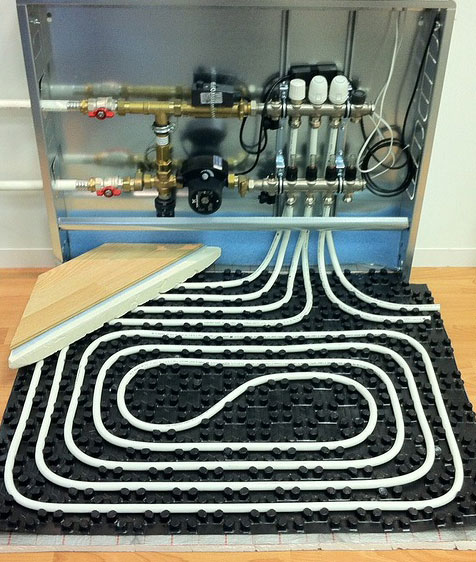 Advantages when installing collector systems:
Advantages when installing collector systems:
- It is possible to use hidden pipelines.
- convenient for installation, since there are no pipe connections in the floor.
- ease of adjustment of individual loops of the heating system.
- the ability to turn off the radiator along with the supply pipes without turning off the entire heating system, that is, the ability to replace a separate section during the operating mode of the system.
- ease of installation of water heated floors. The warm floor is connected as a separate independent circuit. This is due to the fact that the temperature of the coolant in the underfloor heating system is lower than in the heating system, which is ensured by installing a special mixing circuit.
The heating distribution manifold is equipped with many terminals intended for connecting heating devices and consists of two interconnected parts: supply and return manifolds, combined into a single block. The first directly controls the feed hot water to the circuits, and the reverse proportionally distributes the coolant to heat each room in private houses. If the house has two or more floors, then collectors are installed separately on each. Such a system is very convenient, because it allows you to regulate the temperature on each floor and in each room, and in case of emergency it is enough to simply turn off the necessary circuit without turning off the heating in the rest of the house.
In case of use radiator heating together with warm floors the absence of a distribution manifold can lead to the fact that the coolant will flow unevenly into different circuits of the system, and, for example, there will be a hot floor and cold radiators, or vice versa. Thanks to this distribution, the radiators heat up evenly, since each has a separate supply pipe.
Types of heating collectors
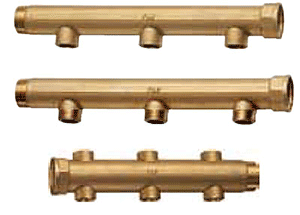 Unregulated collectors
Unregulated collectors
When precise adjustment of flow in the heating or water supply system is not required, it is enough to simply install distribution manifold without valves and connect pipes of the required diameter to the bends. For this purpose, you can use unregulated manifolds with a diameter of 3/4" and 1" with a distance between taps of 36 mm. Such collectors can be of pass-through or end-type.
End manifold
An end-type manifold is a manifold with an inlet on one side only, and the other side has no passage, eliminating the need to install a plug and the possibility of additional risk of leakage at that location. 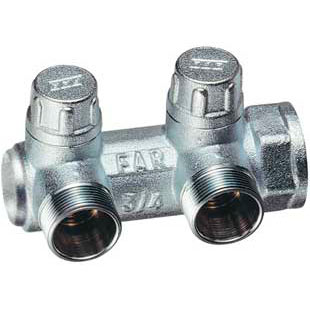 If it is necessary to shut off the flow, it is better to use manifolds with a distance between taps of 50 or 100 mm, which will provide the possibility of installing ball valves sized 1/2” or 3/4”. The diameter of the collectors with a distance between taps of 50 can be 3/4”, 1” or 1 1/4”.
If it is necessary to shut off the flow, it is better to use manifolds with a distance between taps of 50 or 100 mm, which will provide the possibility of installing ball valves sized 1/2” or 3/4”. The diameter of the collectors with a distance between taps of 50 can be 3/4”, 1” or 1 1/4”.
Depending on the size of the outlet
- one manifold outlet with a diameter of 3/4”, 1” or 1 ¼” with center distance 36 or 50 mm has a throughput of 5 to 9 m3/hour and can provide a flow rate of ~ 1 m3/hour at a flow speed of 1 m/sec. Such collectors are mainly used for floor or apartment distribution;
- one collector outlet with a diameter of 1”, 1 ¼”, 1 ½” or 2” with a center distance of 100 mm has a throughput capacity of 7 to 17 m3/hour and can provide a flow rate of 1 to 2 m3/hour at a flow speed of 1 m /sec.
Collectors with an increased distance between taps (100 mm) are recommended to be installed in main distribution areas: in cottage boiler rooms or in house water supply input areas. These manifolds have diameters ranging from 1”, 1 ¼”, 1 ½” or 2” and outlet sizes of ½”, ¾” and 1”.
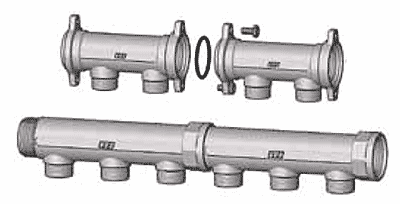 1” diameter manifolds can be threaded or flanged. The flange connection of the collectors ensures 100% location of the collector outlets in the same plane.
1” diameter manifolds can be threaded or flanged. The flange connection of the collectors ensures 100% location of the collector outlets in the same plane.
Manifolds with built-in control and shut-off and balancing valves.
Regulating manifolds allow not only to completely open/close the flow, but also to accurately regulate the flow rate for each consumer. They are installed in hydraulic systems with pressures up to 10 atm and temperatures up to 100°C. Manifolds with built-in control valves can be installed on the flow and return lines. Flow control is carried out without using special tools. The sealing ring (made of EPDM) on the valve seat ensures reliable operation of the valve over a long period of operation.
End control manifolds with an inlet on one side only (the other side has no passage) eliminate the need for a plug and the potential for additional risk of leakage where the plug connects to the manifold.
The valve control handle and lockable shut-off cap are located on the front surface, providing the user with ease of service without the need for special tools.
Underfloor heating manifolds
Shut-off and balancing manifolds with built-in vertical valves can be installed in the water supply or heating system (on the supply and return lines).
Shut-off and balancing manifolds, equipped with a flow meter, allow you to measure and shut off the flow of liquid and balance the branches of underfloor heating and cooling supply. Based on the flow meter readings, the required flow rate can be set. The flow can be completely blocked by tightly twisting the handle.
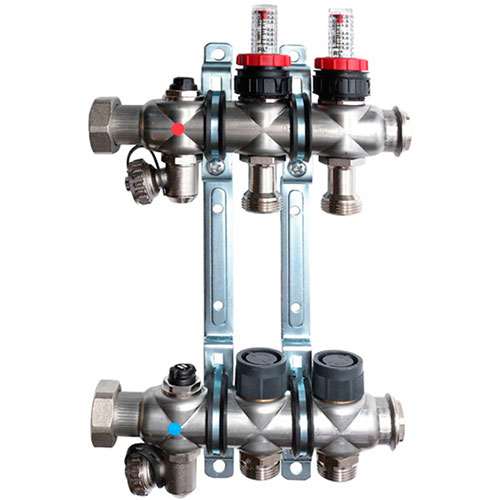
Thermostatic manifolds. Installed in the heating system on the return line if necessary manually or automatic adjustment room temperature.
Installed in the heating system on the return line if necessary manually or automatic adjustment room temperature.
Automatic adjustment is ensured by installing electrothermal heads instead of adjusting knobs. The electrothermal head, depending on the thermostat signal, provides the opening/closing value of the coolant passage and is intended for installation on thermostatic valves as a two-position (open/closed) control servo drive. Electrothermal heads operate on the ON-OFF principle (open/closed) from the electrical signal of an external thermostat with voltage alternating current 220V or 24V. Automatic maintenance of the required thermal conditions (room temperature, heated floor surface, etc.) can be carried out using thermostats. When voltage is applied, the thermal material heats up and the valve stem moves. When there is no voltage, the valve is in the closed position.
The comb can additionally be equipped shut-off valves, circulation pumps, thermometers and pressure gauges, deaerators, which together provide complete control over the movement of the coolant.
note what if you plan to use collector heating, then keep in mind that it will not be able to work without a circulation pump!
When purchasing a collector, you should pay attention not so much to the material from which it is made, but to its technical specifications: maximum permissible pressure, number of outlets, level bandwidth, the ability to add additional circuits if the number of radiators increases, the presence of automatic auxiliary devices.
Today, manufacturers offer many models of such devices, among which you can find devices that have a maximum set of elements: flow meters can be mounted on the supply part, which regulate the flow of the coolant in each loop, and temperature sensors can be installed on the return part to automatically control the temperature of each heating device. The price of such a collector will, naturally, be much higher.
Collectors for radiator heating serve as the main distributor of coolant consumption between all heating devices in the circuit. With their help you can control the heating in each individual room.
The sale of components on the site implies a factory warranty. Valid for the buyer affordable prices on collectors for radiator heating, because We have established our own channels of cooperation with manufacturers.
Design and types of collectors
Radiator heating distribution combs consist of two main parts - supply and return manifolds a. The first serves to regulate the supply of coolant, and the second serves to proportionally heat the premises by balancing the pressure in each branch. The distribution into types is conditional and implies the assembly of the unit:
- automatic air release valves for water drainage;
- electronic mixers and valves to maintain a given temperature;
- automatic thermostats - maintaining the pressure in the system within the normal range;
- coolant supply control units;
- pressure and temperature level sensors.
The price of the unit will depend on the configuration and number of circuits. The device is equipped with shut-off valves to shut off the flow along each branch.
In order for the collector wiring for radiator heating to work, it is necessary. Before making a choice, consult our experts. They will assist in the selection optimal models in terms of cost and capabilities.
Where to buy a radiator manifold in Moscow
In our store you can inexpensively order manifolds for radiator heating from leading manufacturers Oventrop, Stout, Tiemme, Watts. We strive to make customer service as comprehensive as possible. Therefore, we will deliver your order to any address in Moscow and the region. If you decide to buy a collector from us, you get the opportunity to use professional installation services.
The company website offers to buy manifolds for home heating (technical information and prices are indicated in the catalogue). Discounts are provided to regular customers and a quality guarantee for the product. We offer delivery services, installation of equipment and its Maintenance during operation.
Purpose and scope of application of the heating comb
This equipment is considered auxiliary and is used most often in “warm floor” systems, but is also found in radiant (two-pipe) radiator heating systems. The heating comb (collector) is designed to distribute, control and regulate coolant flows in the house.
The device consists of two main blocks:
- server,
- the opposite.
Pipes extend from the first to supply hot coolant from the boiler to heating appliances. The return block receives used liquid, which is sent for heating.
Such a collector for heating radiators is usually mounted in a hidden place in the house:
- under the stairs;
- in a special cabinet;
- in the technical room.
According to the current rules, the supply block is placed on top, and below - to receive the return. To avoid heat loss, the pipes are enclosed in special thermal insulation in red and blue colors.
Design features and price of the heating collector
This device is a pipe made of brass, stainless steel or plastic with bends welded to it perpendicular to the longitudinal axis. The latter are equipped with threads or collet connectors for connecting heating system pipes. The number of outlets on the comb must correspond to the number of mounted radiators (one for each). There may be two or more depending on the model.
Flow valves are installed on the supply manifold for the heating system - one at each outlet. They are designed to regulate the amount of coolant and its uniform distribution between the connected batteries.
Thermal heads (thermoelectric drives) are mounted on the return heating comb - one for each pipe. Using this equipment, you can change the flow area. This regulates the heat transfer to each battery.
The price of a heating comb depends on several factors:
- number of bends and diameter of connected pipes;
- availability of auxiliary shut-off and control valves;
- material (brass, stainless steel);
- protective (decorative) coating;
- brand.
Operating principle of a water heating collector
This equipment is positioned as auxiliary. The coolant flows from the boiler into the supply comb in one stream, where it is distributed through the pipes of the heating circuits. The flow can be controlled on each "loop" (battery) using a flow valve.
After passing through the radiator, the cooled water is delivered to the return manifold of the heating system. Its quantity is regulated using thermal heads and other accessories.
Advantages of a collector system
Connecting radiator heating through a comb makes it possible to make each radiator an independent zone and regulate the degree of heating of each radiator (or room) in the building. For example, you can turn off heating to non-residential rooms on the second floor and save energy resources. In other rooms, on the contrary, it is possible to increase the intensity of heat exchange.
In the event of an accident, using a comb you can easily turn off only one problematic battery without shutting down the entire heating system. This is especially important in winter, if the repairs take a long time.
Are you planning to buy a branded manifold for underfloor heating in a private home?
Collectors are designed for distributing liquid from the main line through additional circuits, for mixing and uniformly distributing flows from parallel pipeline branches, as well as for return collection during circulation. Collectors for radiator heating improve the properties and characteristics of heating systems in buildings for various purposes.
Collector design
The design of a collector for a heating system is quite simple: it is a piece of pipe with a certain number of end and side outlets for connecting individual circuits. There are devices equipped with a security group, mixing unit, air vent, automatic or manual flow regulators. Such equipment is used only in circulation closed systems heating and provides automated control them.
Types of collectors for heating systems
Depending on the design features and purpose, collectors are divided into 4 types:
Distribution manifold
The most common type, separating coolant flows according to heating devices. It consists of 2 distributors (combs), at the ends of which devices are installed for connecting to the supply and return lines. Along the body there are fittings for heating devices (floor heating circuits or loops, heating radiators). Through the first distributor, the coolant flows to the heating devices, and through the second, it is discharged back to the boiler. The connection of radiator-type heating through the distribution manifold is carried out in parallel, and not in series, as in one- and two-pipe schemes.
Hydraulic manifold or thermohydraulic distributor
Designed for hydrodynamic balancing heating system complex type(With several heating circuits). Equalizes the temperature and pressure of the coolant in different circuits, while the flows can be mixed to the required extent. This ensures a stable temperature in the premises, as well as gentle operation of the equipment.
With pump
The thermo-hydraulic distributor allows you to achieve optimal performance heating systems in a large building when each circuit is equipped with a pump. This type of collector is different large diameter and is installed vertically in the boiler room.
Solar
Directs solar energy for economic needs. As a main source of heating, it is suitable for heating water in water pipes located in areas with sufficient levels of sunlight. Fittings of this type differ in design from a conventional collector and often serve as a heat exchanger.
Installing a collector for radiator heating will allow you to use the system as efficiently as possible, which will ensure rational heating of the premises.
